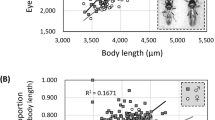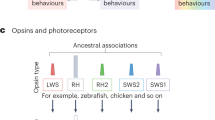Abstract
In 1928 Hartline noted that the lateral eye of the horseshoe crab, Limulus polyphemus, was an admirable preparation for research in visual physiology. Since that time, extensive studies of Limulus have yielded fundamental understandings of visual processes and of sensory processes in general1,2. However, except for demonstrations of primitive phototaxis3–5, studies have not yet revealed a possible role of vision in the animal's behaviour. We have further investigated the problem by studying mating behaviour, the only known behaviour exhibited by Limulus in its natural habitat. We report here that horseshoe crabs discriminate form and contrast during mating: males are attracted to painted cement castings of the female carapace and other forms, the degree of attraction depending on the form and contrast of the castings, and on the time of day. The discrimination of form may result from information transmitted by several sensory systems but the discrimination of contrast requires vision.
This is a preview of subscription content, access via your institution
Access options
Subscribe to this journal
Receive 51 print issues and online access
$199.00 per year
only $3.90 per issue
Buy this article
- Purchase on Springer Link
- Instant access to full article PDF
Prices may be subject to local taxes which are calculated during checkout
Similar content being viewed by others
References
Hartline, H. K. in Les Prix Nobel in 1967, 242–259 (Nobel Foundation (1968), 1969).
Ratliff, F. & Hartline, H. K. Studies in Excitation and Inhibition in the Retina (The Rockefeller University Press, New York, 1974).
Cole, W. H. J. gen. Physiol. 5, 417–426 (1923).
Wolf, E. & Zerrahn-Wolf, G. J. gen. Physiol. 12, 783–787 (1937).
Lall, A. B. & Chapman, R. M. J. exp. Biol. 58, 213–224 (1973).
Lockwood, S. Am. Zool. 4, 257–274 (1870).
Wyse, G. A. Z. vergl. Physiol. 73, 249–273 (1971).
Kaplan, E., Barlow, R. B. Jr, Chamberlain, S. C. & Stelzner, D. J. Brain Res. 109, 615–622 (1976).
Barber, S. B. J. exp. Biol. 131, 51–74 (1956).
Barlow, R. B. Jr, Bolanowski, S. J. Jr & Brachman, M. L. Science 197, 86–89 (1977).
Kaplan, E. & Barlow, R. B. Jr, Nature 286, 393–395 (1980).
Barlow, R. B. Jr, Chamberlain, S. C. & Levinson, J. Z. Science 210, 1037–1039 (1980).
Author information
Authors and Affiliations
Rights and permissions
About this article
Cite this article
Barlow, R., Ireland, L. & Kass, L. Vision has a role in Limulus mating behaviour. Nature 296, 65–66 (1982). https://doi.org/10.1038/296065a0
Issue Date:
DOI: https://doi.org/10.1038/296065a0
This article is cited by
-
The median eyes of trilobites
Scientific Reports (2023)
-
Eye and clasper damage influence male mating tactics in the horseshoe crab, Limulus polyphemus
Journal of Ethology (2006)
-
On the molecular origin of photoreceptor noise
Nature (1993)
-
Efferent neurotransmission of circadian rhythms inLimulus lateral eye
Journal of Comparative Physiology A (1988)
Comments
By submitting a comment you agree to abide by our Terms and Community Guidelines. If you find something abusive or that does not comply with our terms or guidelines please flag it as inappropriate.



